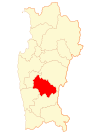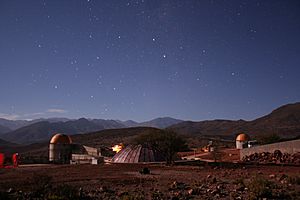Combarbalá facts for kids
Quick facts for kids
Combarbalá
|
|||||
|---|---|---|---|---|---|

Main square and San Francisco de Borja church
|
|||||
|
|||||
| Country | |||||
| Region | |||||
| Province | Limarí | ||||
| Founded | November 30, 1789 | ||||
| Government | |||||
| • Type | Municipality | ||||
| Area | |||||
| • Total | 1,895.9 km2 (732.0 sq mi) | ||||
| Elevation | 904 m (2,966 ft) | ||||
| Population
(2012 Census)
|
|||||
| • Total | 13,605 | ||||
| • Density | 7.1760/km2 (18.5858/sq mi) | ||||
| • Urban | 5,494 | ||||
| • Rural | 7,989 | ||||
| Sex | |||||
| • Men | 6,695 | ||||
| • Women | 6,788 | ||||
| Time zone | UTC−4 (CLT) | ||||
| • Summer (DST) | UTC−3 (CLST) | ||||
| Website | Municipality of Combarbalá | ||||
Combarbalá is a city in Chile, known for its unique culture and history. It is the main city of the Combarbalá commune. You can find it in the Limarí Province, within the Coquimbo Region. The city sits high up, about 900 meters (2,952 feet) above sea level.
Combarbalá is famous for many things. These include the Cruz del Sur astronomical observatory, ancient rock carvings called petroglyphs, and special crafts made from a stone called combarbalita. People also love the exciting basketball match at the end of February and the unique "Virgen de la Piedra" festival.
Contents
What Does the Name Combarbalá Mean?
There are two main ideas about where the name "Combarbalá" came from. Both ideas suggest the name comes from old local languages.
One idea is that "Combarbalá" comes from the Quechua word "Cumparpayay." This word means "to break with a hammer." It describes how people used to get minerals and stones from mines.
The second idea says the name comes from the Mapudungun words "Co Cam Bala." "Co" means water, "Cam" means far, and "Bala" means duck. So, "Cocambala" means "far away water with ducks" or "Duck's pond." There is actually a place called Duck's pond near the city. This pond was a resting spot for the Inca army and later for Spanish explorers like Diego de Almagro and Pedro de Valdivia.
People in Combarbalá also have a funny story about the name. They say a local person named "La" traveled with the Spanish. When "La" came back, he had a thick beard, which was unusual for local people. So, people started calling the area "Con-Barba-La," meaning "with-beard-La." This story is often told to kids during the city's founding celebration.
Combarbalá's Rich History
Ancient People of Combarbalá
The land where Combarbalá is today was first home to different groups of people. These included the Molle, Diaguita, and Inca people.
The Molle people were the first to live here, from about 400 BCE to 900 CE. They were hunter-gatherers, meaning they hunted animals and gathered plants for food. They also did some simple farming.
The Diaguita people arrived around 700 CE. They came from Argentina by crossing the Andes mountains. They were skilled farmers and made beautiful pottery, stone work, and weaving. They also worked with metals like copper and bronze. The Diaguita people carved figures into stones, called petroglyphs. These carvings are believed to show their ideas about the universe. You can still see many of these amazing carvings in the Rincón las Chilcas area.
The Inca conquerors came around 1450 CE. It is thought that their arrival was peaceful. They improved the Inca roads in the area and were very good at mining and agriculture.
Spanish Arrival and Colony Life
The Spanish explorer Diego de Almagro came to the area around 1536. His trip was not successful, and he soon returned to Peru. Later, Pedro de Valdivia arrived in 1541. They found the valley mostly empty because the local people were hiding. They were scared because of what Almagro's group had done.
The first Spanish writer to mention the "Cocambala" valley was Jeronimo de Vivar. He wrote that it rained more in summer than in Copiapó and that there were good rivers. He also said there were "Not too many people" living there.
Life in the area was very hard before the city was officially founded. An early count showed only 240 people in the whole area. Most people worked in farming and raising sheep. In 1757, the population grew to about 1,140 people.
On November 30, 1789, the city was officially founded. Its first name was "Villa de San Francisco de Borja de Combarbalá." Captain Juan Ignacio Flores founded the city under the orders of Governor Ambrosio O'Higgins.
In the early 1800s, people found copper, gold, and silver mines in the area. Combarbalá became an important mining center. However, in the 1980s, the mining plant closed down. This ended the time of mining wealth and caused economic problems for the city. Later, in the 1990s, people started growing grapes for export. This became the main economic activity, but it only provides jobs during certain seasons.
Combarbalá's Geography
The Combarbalá commune is in a special area of Chile called the transversal valleys. These valleys run from the Andes mountains to the coast. The city of Combarbalá is right next to the Combarbalá River. The valley is between the Cogotí River valley to the north and the Valle Hermoso (Beautiful Valley) to the south. These three are the main valleys in the commune.
Some important hills in the Combarbalá commune include:
- Pabellón Hill: 4,700 meters (15,420 feet) above sea level.
- Chaguareche Hill: 2,612 meters (8,570 feet) above sea level.
- Ramadilla Hill: 1,353 meters (4,439 feet) above sea level.
- Movilo Hill: 1,230 meters (4,035 feet) above sea level.
Combarbalá's Population
According to the 2002 census, Combarbalá covers an area of 1,895.9 square kilometers (732.0 square miles). It has 13,483 people living there. This includes 6,695 men and 6,788 women. About 5,494 people (40.7%) live in urban areas, which are cities and towns. The other 7,989 people (59.3%) live in rural areas, like the countryside. The population decreased by 6.3% between 1992 and 2002.
How Combarbalá is Governed
Combarbalá is a commune, which is like a local district. It is managed by a municipal council. The head of the council is the alcalde (mayor), who is chosen by the people every four years. The mayor from 2008 to 2012 was Solercio Rojas Aguirre.
The council also has members who help make decisions for the commune.
Combarbalá's Climate and Nature
Combarbalá has a semi-dry climate. This means it's often dry, with about 50% humidity. In summer, temperatures are usually between 24 and 33 degrees Celsius (75 to 91 degrees Fahrenheit). Nights are much cooler, like in a desert. In winter, temperatures are usually above freezing, around 3 degrees Celsius (37 degrees Fahrenheit). Most of the year is clear and sunny.
The area gets about 200 millimeters (8 inches) of rain each year. However, sometimes there are long dry periods, and other times there are very heavy rains.
The plants in Combarbalá are special because they can live in dry conditions. You will mostly see different types of cacti, hawthorns, and carob trees. But near the rivers in the valleys, you can find plants that need more water, like Eucalyptus trees and Weeping Willows.
The rivers in the area get their water from two sources: rain and melting snow. So, their water levels go up twice a year: in winter from rain and in summer from melting snow.
There are many small rivers that flow down from the Andes mountains. These rivers all feed into the three main rivers in the commune: Combarbalá, Cogotí, and Pama. All of these rivers eventually flow into the Cogotí dam. This dam can hold a lot of water – about 150 million cubic meters (39 billion gallons)! From there, the water goes into the Guatulame River and then to the La Paloma dam.
Combarbalá's Economy
For nearly 200 years, mining was the most important job in Combarbalá. People mined copper, gold, and silver. But now, mining has become much less important.
Besides mining, other important jobs include farming, raising goats, and making crafts from a special stone called Combarbalita. Many artists in the area use this stone to create beautiful decorations and useful items. Goat cheese is also a famous product from this region. Growing grapes for export has become the main farming activity. However, this only provides jobs during certain times of the year.
Combarbalá also has a small airport called La Pelicana Airport, which is about 13 kilometers (8 miles) north of the city.
Fun Things to Do in Combarbalá (Tourism)
Combarbalá has many interesting places to visit!
Southern Cross Astronomical Observatory
This amazing observatory is open to everyone. It has four large domes, each with a powerful telescope. You can take tours that teach you about astronomy in Chile and how ancient cultures viewed the stars. You can even look at planets and stars through the telescopes!
La Isla Religious Festivals
On the first Sunday in May, people celebrate the traditional "Virgin of the Stone" festival in La Isla. This town is about 22 kilometers (14 miles) from Combarbalá. Thousands of people show their faith by climbing the hill where the stone virgin is located.
This festival mixes old Inca traditions with Catholic beliefs. For example, people make "mandas," which are promises to the virgin. If the virgin grants a wish, the person might do something difficult, like climbing the hill on their knees. Another interesting part is the "religious dances." These dances have Inca roots but now show a mix of native and Catholic ideas. Groups of people, including men, women, and children, dance in lines while a band plays drums and flutes.
Ancient Petroglyphs
The area used to have many petroglyphs, which are ancient rock carvings. These were made by the Diaguita people. Sadly, many were stolen in the past. But you can still find some of these important carvings in areas like Rincón Las Chilcas, Ramadilla, and Pama. These carvings often show the Diaguita people's ideas about the universe and their religious ceremonies.
El Clásico Basketball Match
In February, Combarbalá has a special event called El Clásico (The Classic). Two local clubs, "Los Loros" and "Union Juvenil," compete for the city championship. Even though there's no trophy or money, everyone in Combarbalá and visitors choose a side! Family history often decides which club you support, but young people sometimes switch.
At the end of February, the clubs compete in sports and cultural activities. The winner is decided after an exciting basketball game. This game often starts late at night, after a play and cheerleading performances. It can last until 4 AM! People call it "The Night Combarbalá Doesn't Sleep." The score is usually very close. After the game, both the winners and losers celebrate until morning at their clubhouses.
Other Fun Places to Visit
- Petrified forest: Find ancient fossilized trees in El Algarrobal, just 3 kilometers (1.9 miles) from the city.
- Mountain biking: Enjoy biking in Barrancas, Chineo, and Fragüita, about 11 kilometers (6.8 miles) into the countryside.
- San Francisco de Borja de Combarbalá Church: This historic church was built in 1754. It's a beautiful landmark in the town center.
Notable People from Combarbalá
- Ignacio Silva Ureta (1837–1924), a well-known politician.
Images for kids
See also
 In Spanish: Combarbalá para niños
In Spanish: Combarbalá para niños






